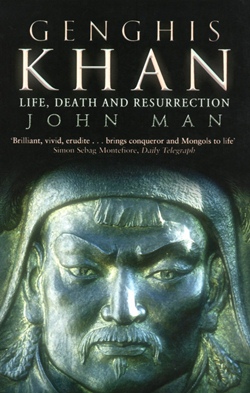If ever you were looking for a real legend, go no further than Genghis Khan. Conqueror of nations across Asia and into Europe, Genghis Khan deserves his place in history, though like many other historical characters, do we really ‘know’ them?
John Man with this book Genghis Khan (ISBN 978-0-553-81498-9, Bantam Books, 2005) hopes to be able to enlighten and illuminate this legendary figure.
The book opens with the startling fact that one in two hundred of males living today share some genetic coding with Genghis Khan. As a conqueror he was certainly a busy chap!

It is no dry and dusty academic work, but is the work of a story teller. In a book about Genghis Khan, would you expect a recipe for casserole of marmot? For this tasty dish the cooking instructions begin with “First shoot your marmot. Using string hang dead marmot from a branch. Skin it, peeling skin carefully downwards to keep skin in one piece. Discard entrails. Ignore flies. Remove and dice flesh…” I think I’ll wait for a boiled egg, but you can get my drift, I am sure.
Much of the book relates to a very early work called the Secret History of the Mongols, and author Man’s interpretation of that. His take on various aspects is a reasoned one, and he is not one for flights of fancy, though one has to look at the most likely interpretations. This book was originally written in Mongolian vertical script, and an explanation is given as to how this came into being and acceptance.
Those were not easy times in the 13th century, and with the capital of Mongolia these days being Ulaanbaatar, a place only known to me as having the coldest recorded temperatures on the weather map, with minus 50 not being unknown. To voluntarily live there smacks of masochism or poverty, or both. However, Ulaanbaatar does have the Genghis Khan University which John Man visits for more details.
As Genghis Khan began to take control of the various tribes, his abilities as a forward thinker become obvious. Having a Mongolian script was necessary if there was going to be a framework for governance, “A new society, especially one of this size, needed new rules and new ways of administration.” These were written down in what was referred to as the Blue Book (AKA The Great Yassa).
Being a historical account, from the records of the time, religion is also covered, with Buddhism, Christianity and Islam all mentioned with the influence they had in many areas taken over by Genghis Khan and his sons who followed him. Genghis Khan, however, did not subscribe to any particular faith, but had the belief that he was guided by Heaven.
At B. 630, this is a fascinating book about a fascinating man. Plenty of references and bibliography to make it enough of a scholarly tome, but written in a very easy to follow way, almost conversational in nature. I really enjoyed this book, and since both my children have Mongolian Blue Spot, that genetic coding is even here in Pattaya. It may also explain the temper tantrums!




